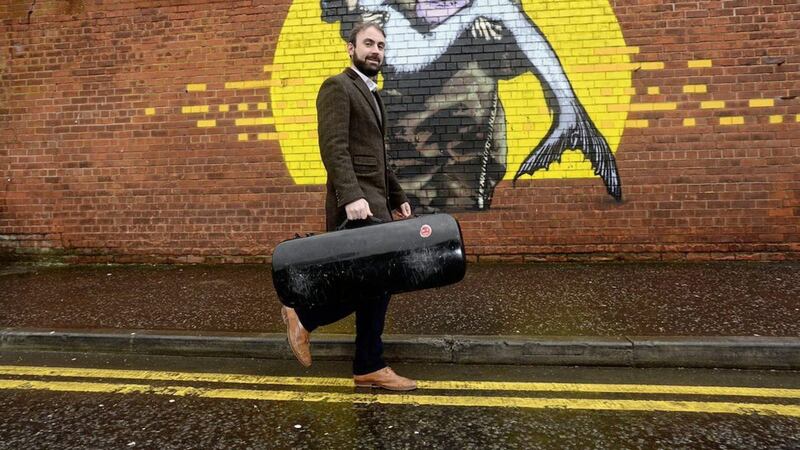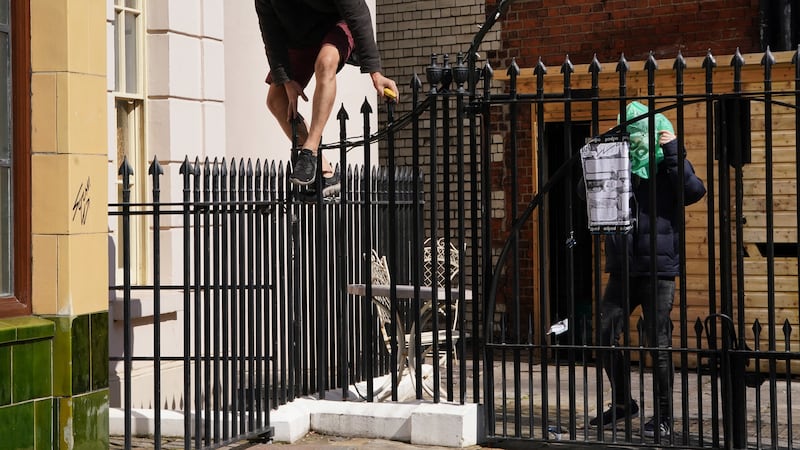I HAVE a friend who wanted to get tickets for the launch of Conor Caldwell’s new album, To Belfast, which was being launched as part of the Cathedral Quarter Arts Festival last month. He was too late. The show was sold out.
I think that that shows the appetite there is for traditional music in Belfast and in the north in general and specifically the esteem in which the north Belfast fiddler is held.
Conor was born just off the Lansdowne Road and went to St Malachy’s College, where he was more interested in kicking football than practising the fiddle.
“It wasn’t until I started first year at the college that I was more or less told by a teacher that I was playing the violin, and that was that!” he recalls.
"But there was always music around my house – I just didn’t appreciate it, really. The summer holidays were spent to a soundtrack of De Dannan and Planxty, which really came to my advantage when I got a bit older as I had absorbed a lot of that music without realising it.
“My earliest influences were my classical violin teacher Nikki Johnson, and Ruadhrai O’Kane who persevered with me with unbelievable patience as I scraped my way through tunes,” he tells me.
Fast forward and today Conor is a fiddle player, musicologist, teacher, and media researcher with an emphasis on traditional and popular music.
While Donegal has its John Doherty and Belfast had its Sean Maguire – Conor briefly went to lessons with Maguire when he was a child – there were other great players in the city.
“For me the king of fiddle music in Belfast is Andy Dickson,” Conor says. “I’ve been lucky to get to know Andy a bit in recent years and he is still playing incredible music. He was part of the gang which first introduced the music of Fermanagh to the city.
“I also think that the fiddle tradition in Belfast has been redefined in recent decades by the likes of Meabh O’Hare, Ruadhrai O’Kane, Donal O’Connor, Martin Dowling and others. But for me the real excitement lies in the cohort who are between the ages of 14 and 18 who are going to be great musicians.
“Sorcha Stockman, Conor Beare and Alex Walsh are just some of the emerging fiddlers who people should really watch out for. They’re going to be brilliant.”
Conor himself never decided to become a professional musician, but he is really i the teaching aspect of the music.
Over the past number of years, Conor has forged a great partnership with another fiddler, Danny Diamond, a Dubliner born to musical Belfast parents. Together, they made a five-star album called North. What did they set out to achieve with the album?
“We definitely wanted something a bit stripped back, maybe raw, and at the same time there was something to be explored in the accompaniment side of things. I had been sharing old tunes from collections with Danny for a few years before that, and he had been writing new pieces quite frequently, and these were bits that really took us into our own space. It was only afterwards that we realised just how extensively the tunes and the aesthetic fitted into the concept of ‘North’ whatever that means to different people.”
For his solo album, however, Conor has gone for a more experimental approach, combining old and new tunes with elctroncia. Indeed it is quite an exciting time for trad music and electronica, as shown by what Jarlath Henderson, John McSherry and Pádraig Rynne and others are doing with the mix, so I asked Conor what he thought electronica adds to fiddle music?
“For me it’s a new space to explore that doesn’t really have any rules or conventions,” he explains. “So much of the tradition is heavily codified, and while I’ve never particularly felt frustrated by that, it’s intriguing and challenging to try something different. You have to keep setting new challenges or you risk stopping your personal development as a musician."
“I have a lot of respect for John and Pádraig, but Jarlath Henderson’s ideas I found particularly inspiring, especially his setting of Courting Is A Pleasure, which I listened to on repeat for about a month in the middle of making this recording.”
While the electonica aspect is state of the art, at the same time, To Belfast harps back (pun intended) to the assembly rooms in 1792 and to Edward Bunting and The Belfast Harpers Assembly.
"We owe so much to Bunting, although some people say he got it wrong – he was only 19 at the time of the assembly. His work was incredible and is invaluable in our understanding of Gaelic Ireland,” says Conor.
“He interpreted the harpers’ music through the lens of his own musical training. It must have been a bizarre experience for him. For me the real magic is in the inspiration he took from the festival, spending the rest of his life curating the most important collection of Irish music in existence."
The other greats are there – O’Carolan and Tom Moore – so, as well as the music, beautiful and intriguing in parts, there is a strong sense of history coming from the sounds. Most people will know Eibhlín a Rúin and Oh, Believe Me of All Those Endearing Young Charms – but Conor has also added his own tunes on To Belfast.
“How do new tunes come into his head, what is the creative process?” I ask.
It’s often very random, Conor admits.
“I tend to have these little motifs that develop in my head. I’ll sing them into my phone or scribble them down and then build a tune out of that. I tend to find that the end result comes very quickly.
"I was on tour earlier this year and made up three tunes in about 30 minutes one afternoon, but then probably haven’t come up with much since! On the recording I definitely got more adventurous as I went on. I like the idea of taking the language of the music – the combination of rhythm and the scales – and coming up with something a bit different that disavows the traditional song and dance tune structures.
“I’m only still getting my head around how to work with these raw materials. It’s something that has eluded composers and arrangers of Irish music for centuries but it’s still worth aspiring toward.”
Conor also sees a connection between the vibrant spirit of radical Belfast in the 1790s and the ever-changing Belfast of today.
“The magnitude of the events surrounding the Harpers’ Assembly and the lead-up to 1798 really resonated for me with modern-day Belfast – this sense of a city with the ability to make its own future and decide what exactly it wants to be. We’ve all got a part to play in that,” he says.
Here here.





